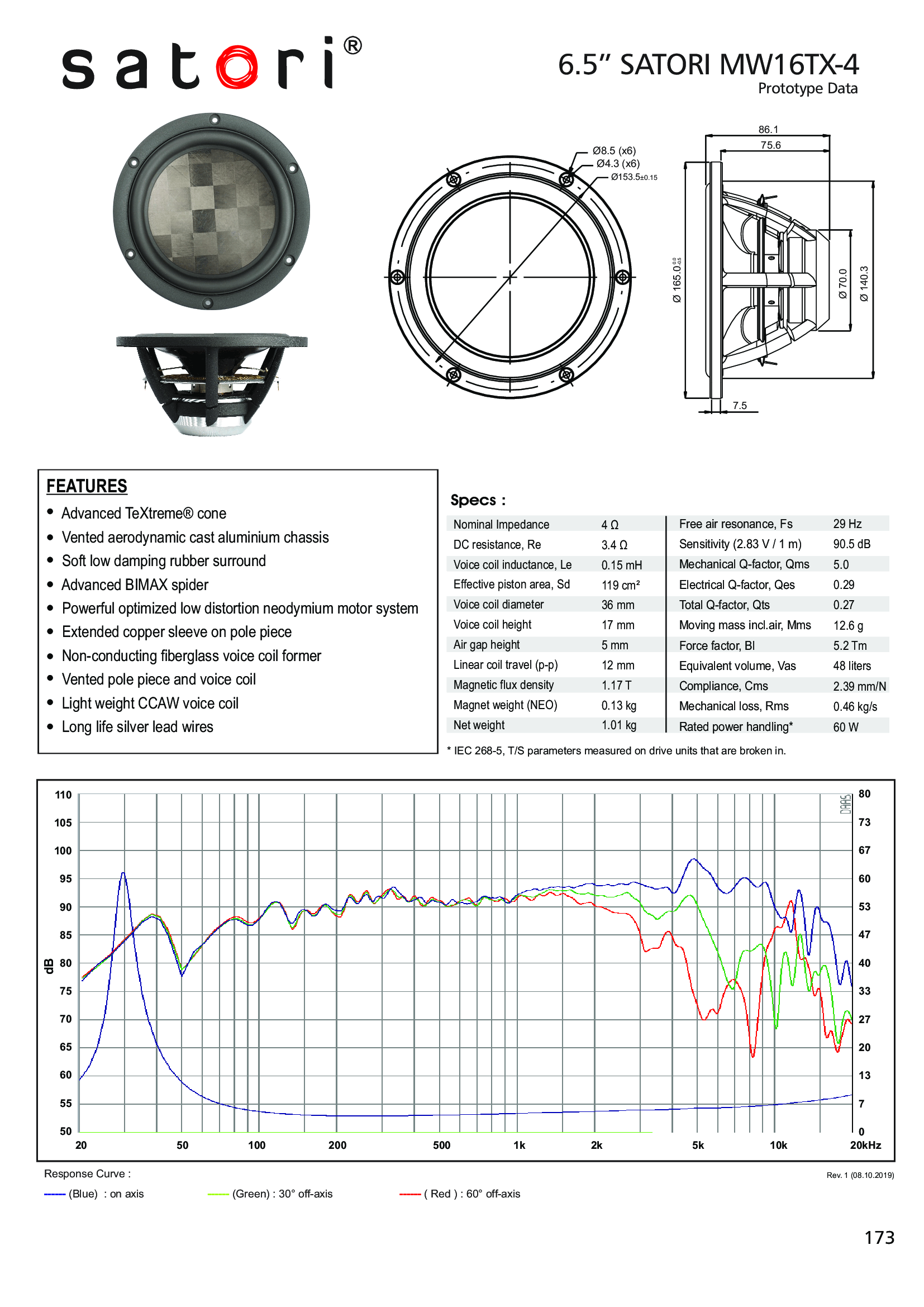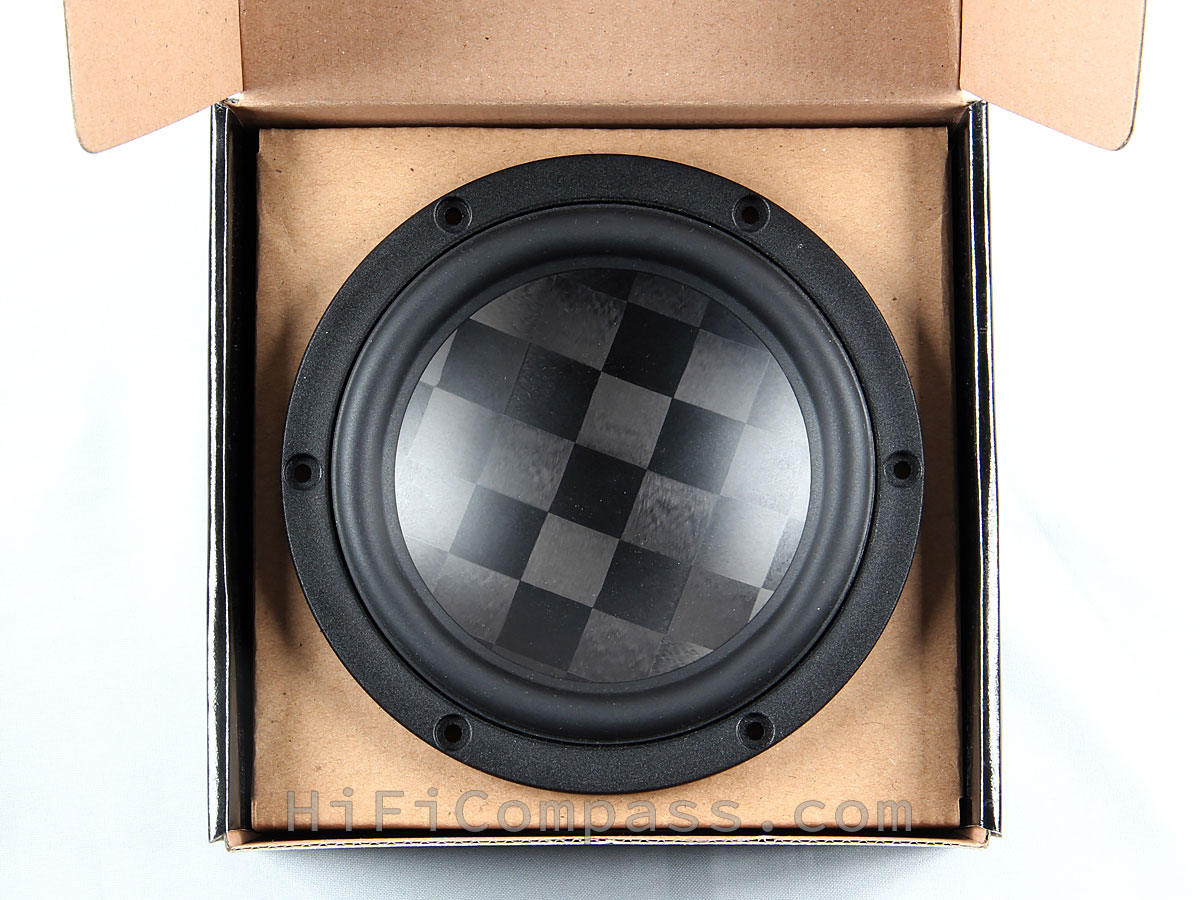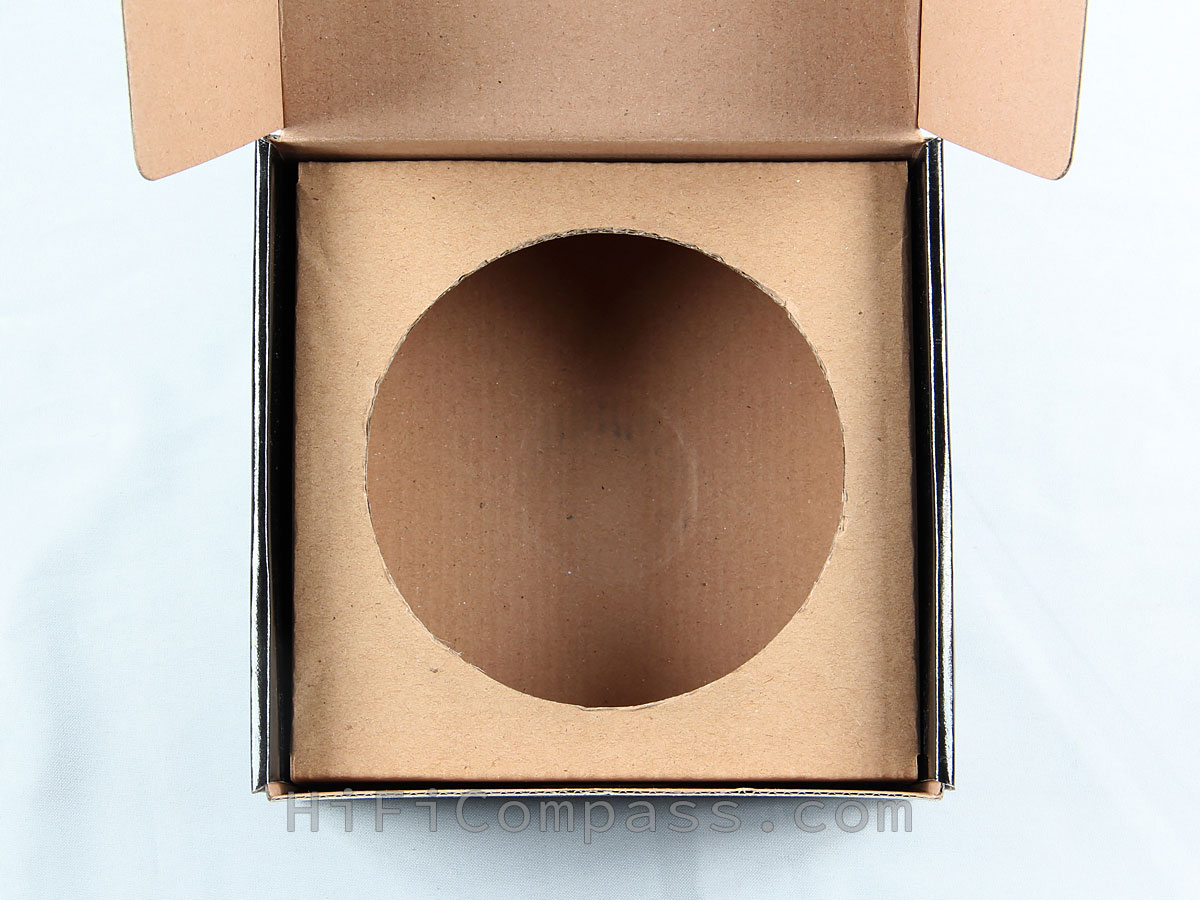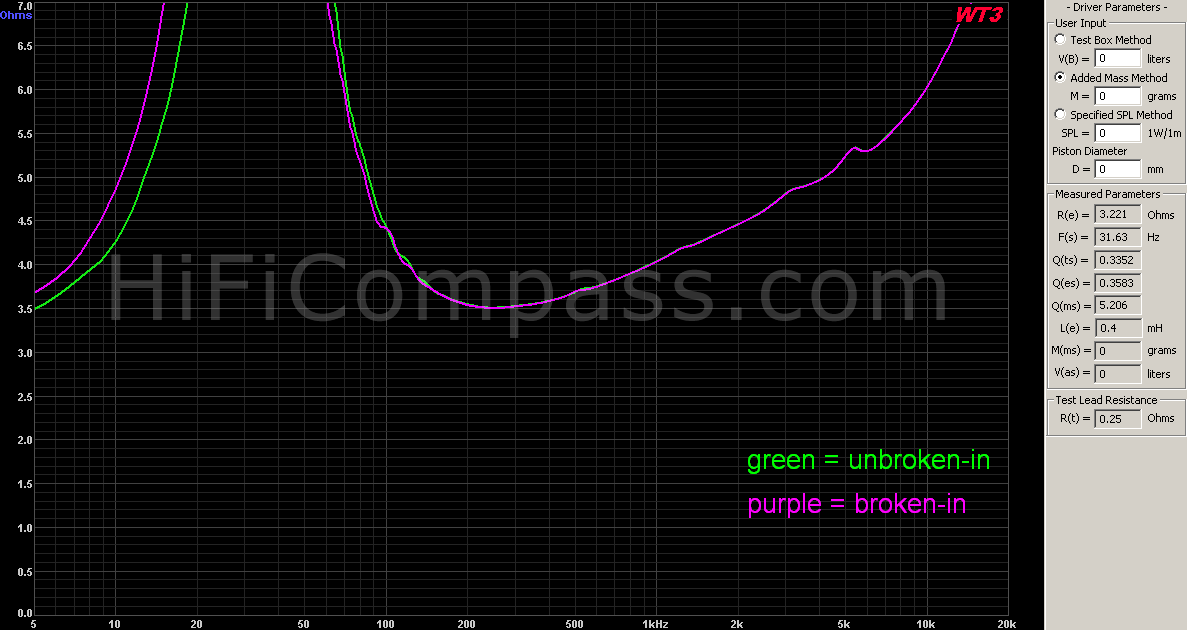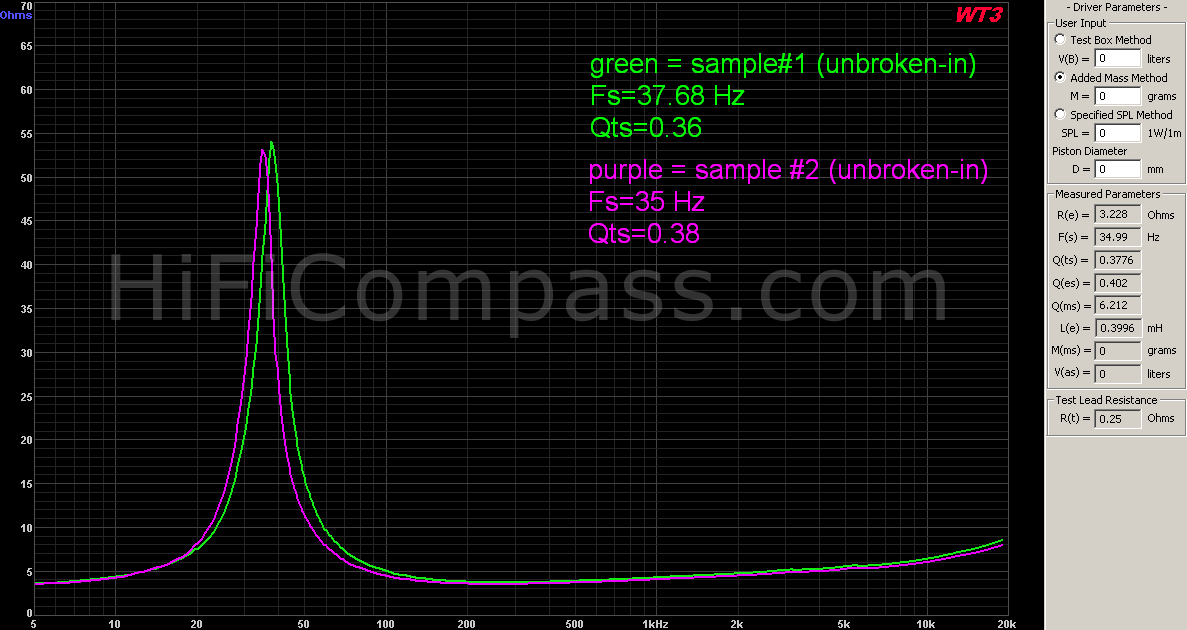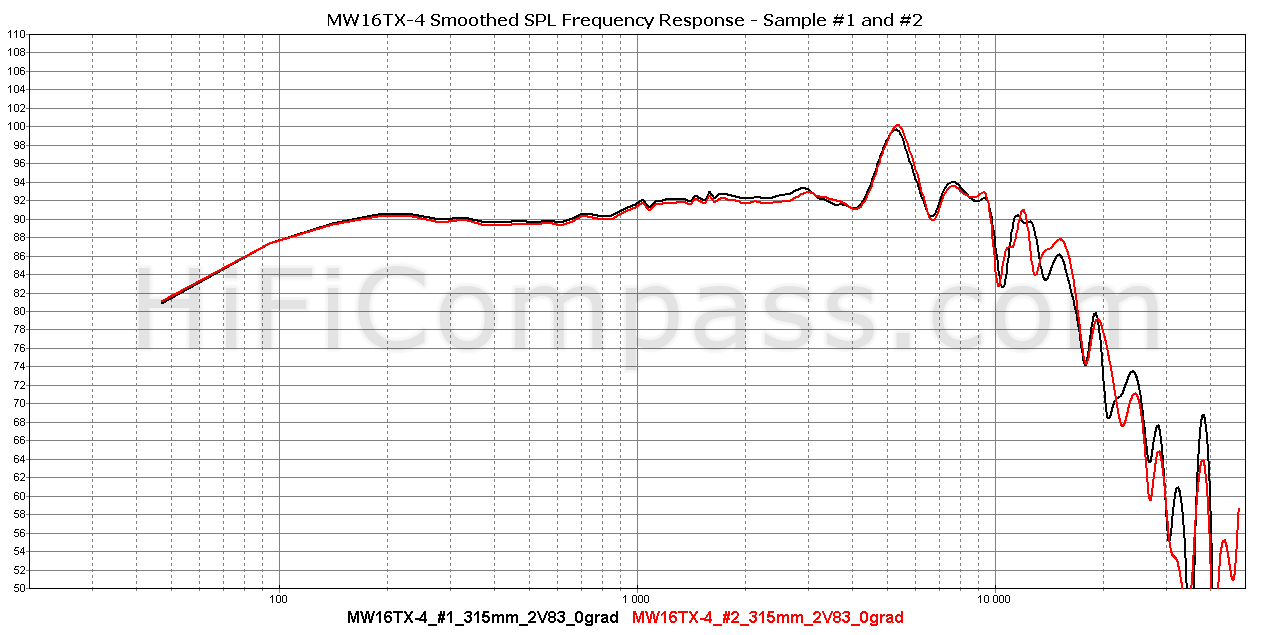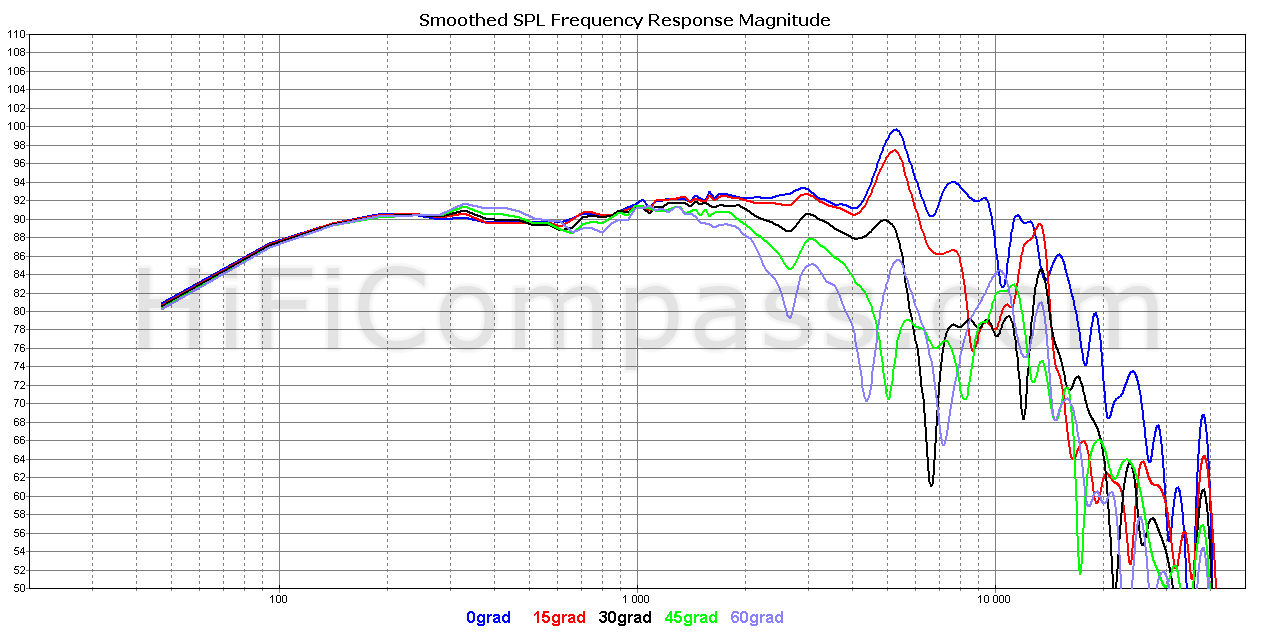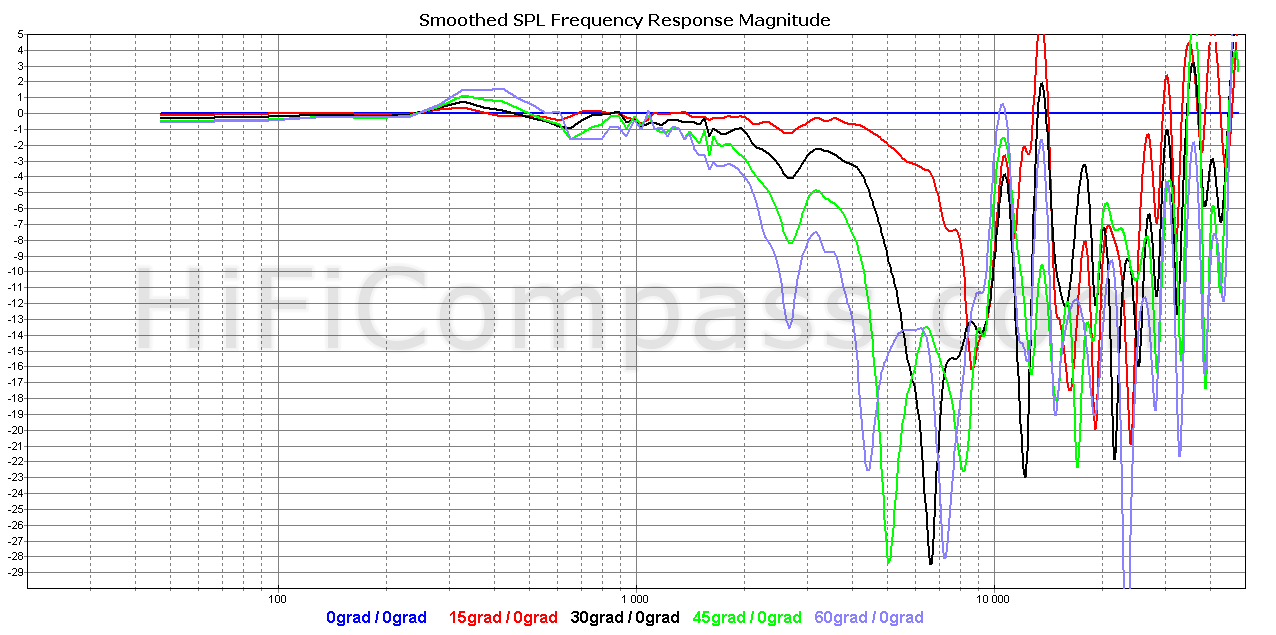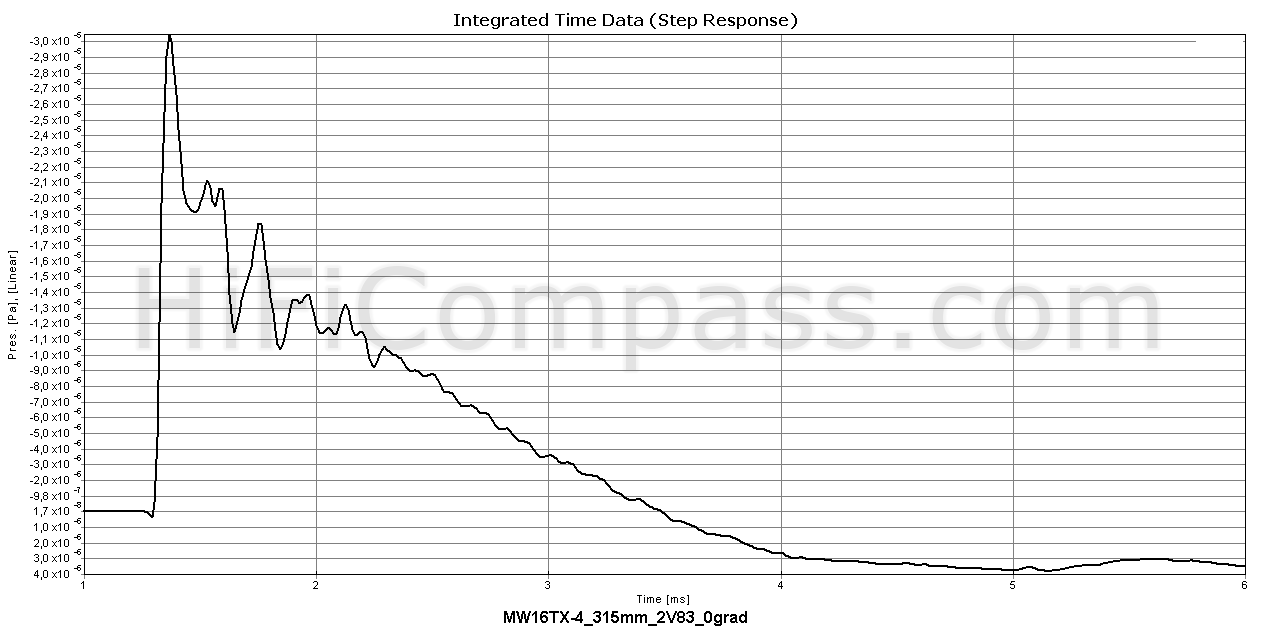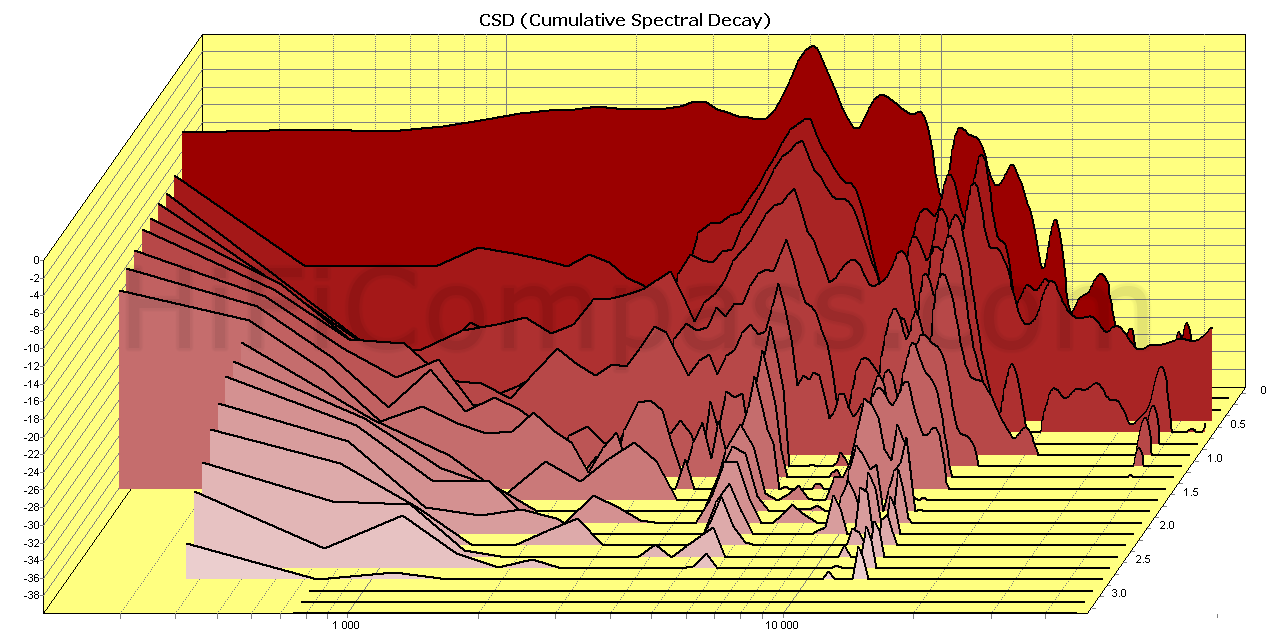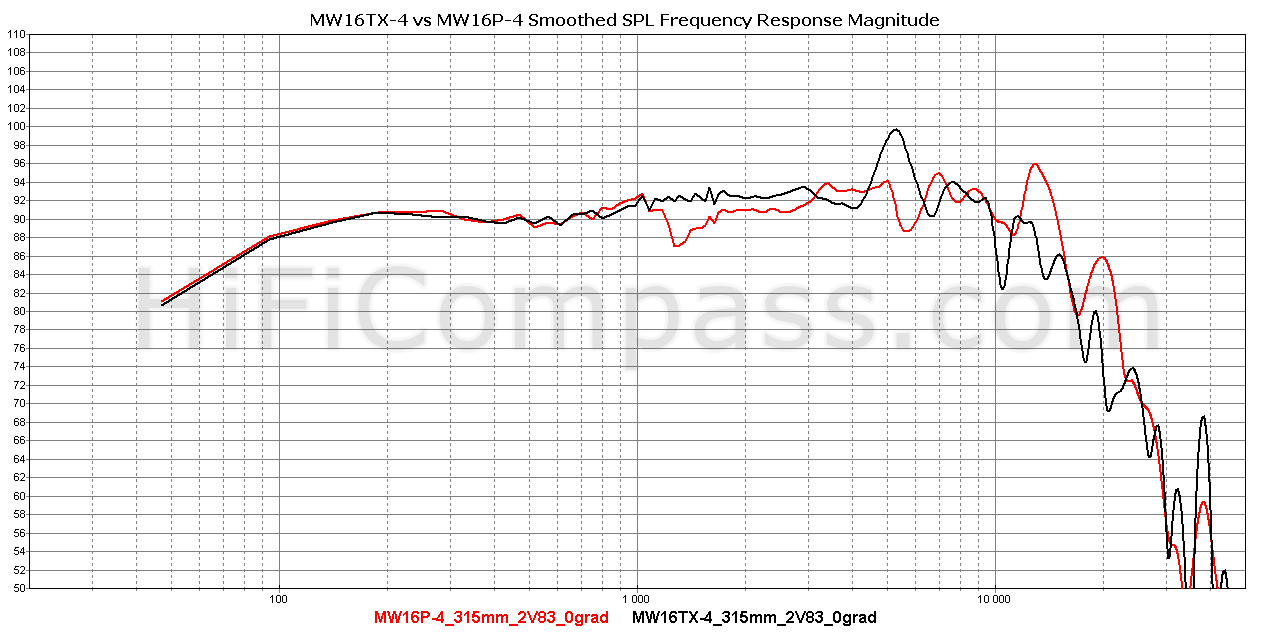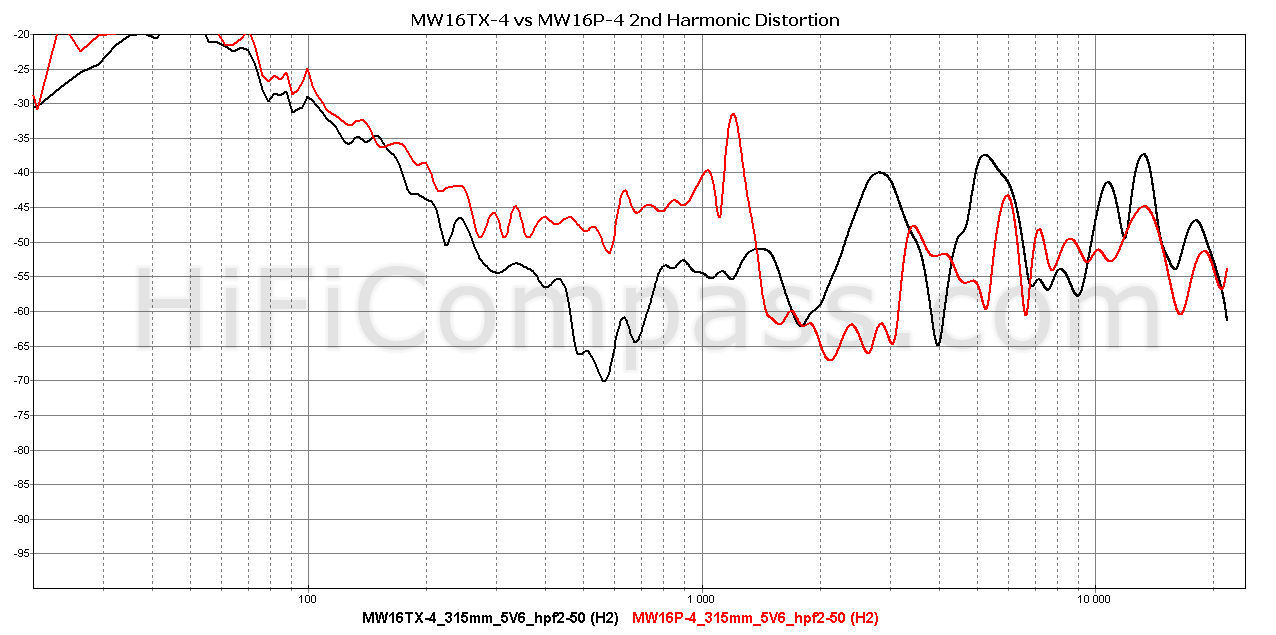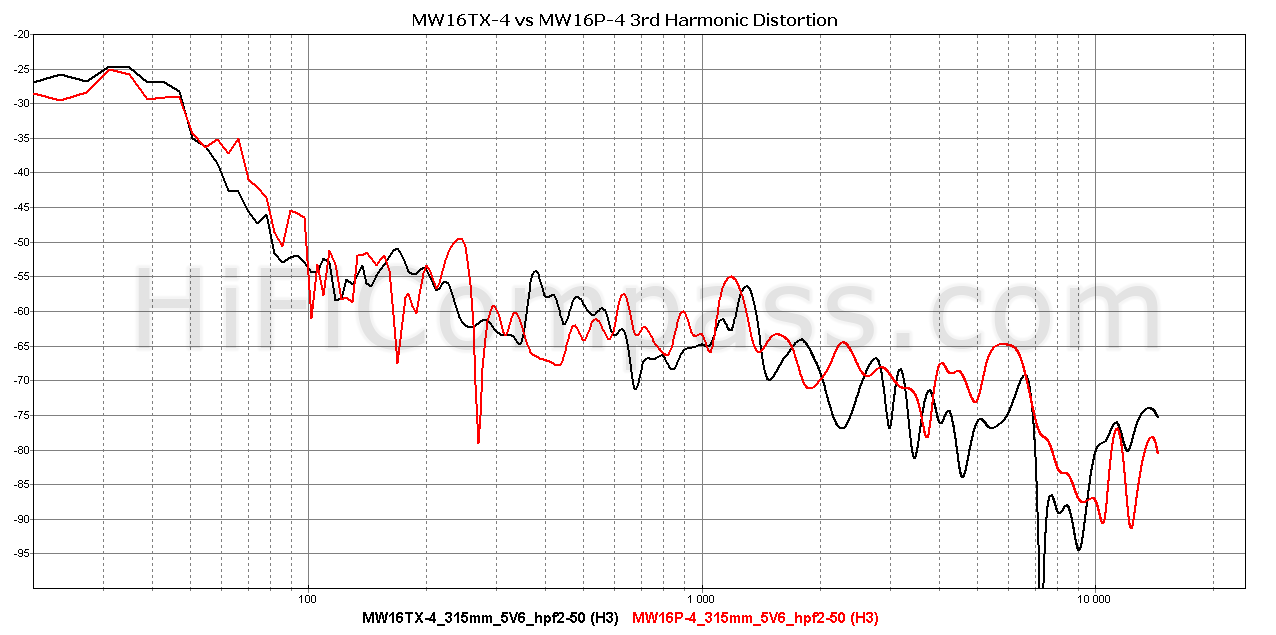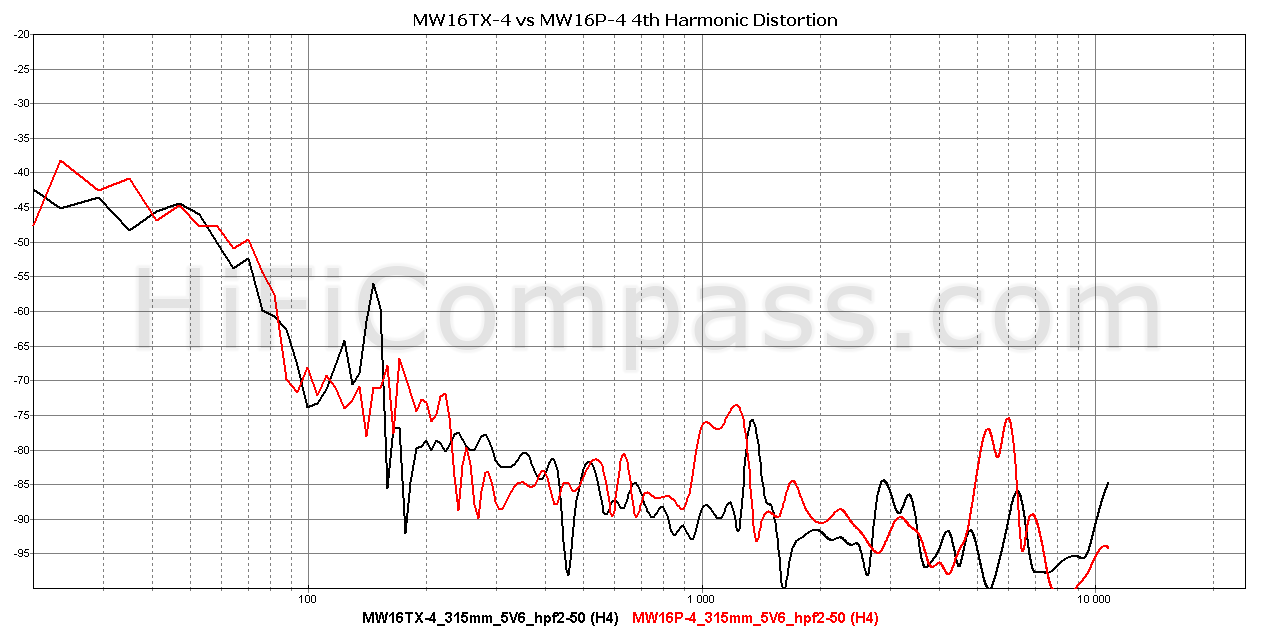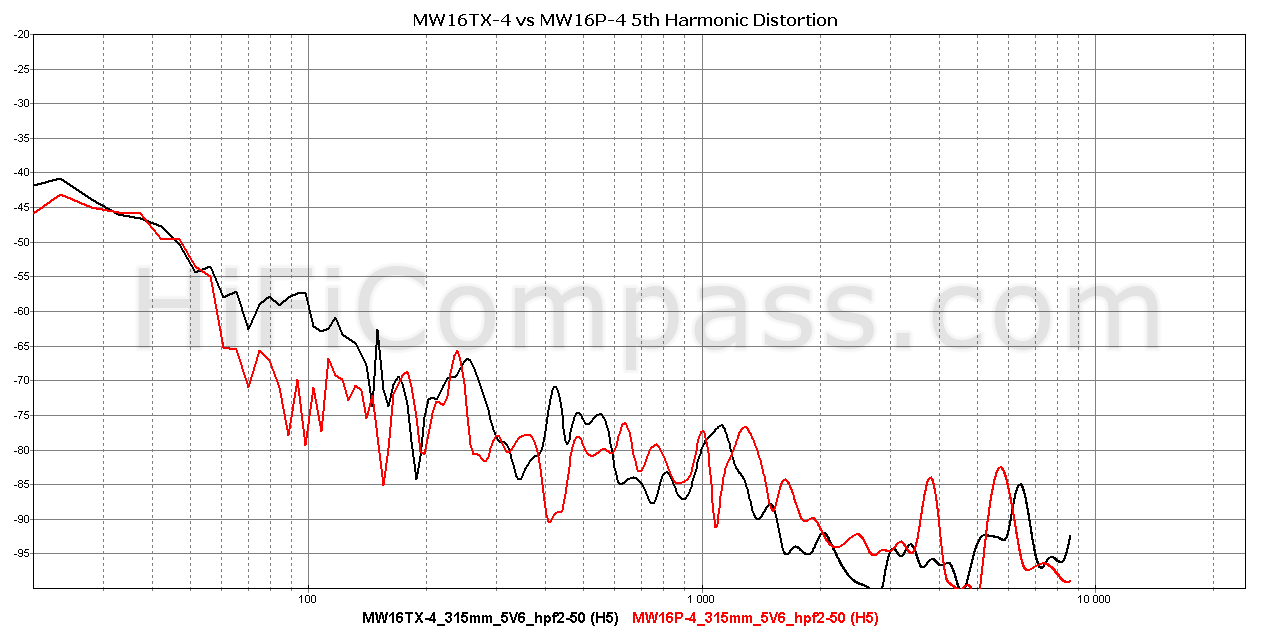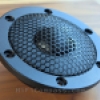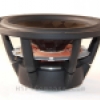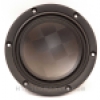HiFiCompass
Satori MW16TX-4
What is on the test bench?
In the third review we begin our acquaintance with the TeXtreme membrane speaker drivers under the Satori brand. Today it is the new 6" midwoofer of the Sinar Baja Electric company - Satori MW16TX-4.
TeXtreme is a new word that came into the "high-end world" in the spring of 2019 and has been exciting audiophiles minds ever since. It all started with the presentation by the Swedish company Oxeon of the newest type of membrane for speakers - TPCD (Thin Ply Carbon Diaphragm) based on TeXtreme, as evidenced by the publication in the AudioXpress magazine. This was followed by the presentation at the Munich HighEnd-2019 by the Satori brand of new speakers using TeXtreme membranes - the Satori TW29TXN tweeter and Satori MW16TX midwoofer, and a demonstration of based on them loudspeakers developed by Danesian Audio.
Oxeon was founded in 2003 and introduced the TeXtreme to the world in 2004. So the material is by no means that new. Since then, it has been widely used as a heavy-duty and lightweight composite material in aviation, sports and industry. It is used to manufacture body parts for racing cars, aircraft seats, protective helmets for athletes, bicycle frames, golf clubs, skis and many more. However, it came in audio only in 2019 with the invention of TPCD membranes.
TeXtreme is a trademark of the company that means three concepts at the same time:
- the technology of converting a conventional multifilament (carbon, aramid, etc.), which is a thread of thousands of microfibers with a diameter of several microns, into a flat tape, where these fibers are strictly oriented parallel to each other (spread tow)
- the technology of weaving fabrics from wide flat tapes (thin ply)
- the fabric itself from these flat tapes
So, the term TeXtreme can mean both the technology of fabrication itself and the fabric itself. In the context of interest to all of us we will mean just the fabric and just from the spreaded carbon fiber.
The main advantages of TeXtreme over conventional carbon fabric are the strictly parallel arrangement of the fibers and the absence of their mutual twisting when they are distributed into flat tapes. This reduces the amount of voids in the yarn. Further, the wide flat tape weaving technology provides a much denser filling of a fabric surface with fibers, significantly reducing the amount of voids that must then be sealed with epoxy. Everything contributes to a higher specific content of carbon fibers in the fabric, greater strength and less weight.
Carbon fibers have been used in the manufacture of speaker membranes for many years and have already managed to take their place in the top models of speaker drivers and loudspeakers leading world companies - Rockport Technologies (USA), Magico (USA), Kharma (Netherlands), Morel (Israel). SB Acoustics also has in its portfolio several carbon fibers membrane models - SB17CRC35-4(8) and SB15CRC30-4(8). A distinctive feature of all the speakers of the aforementioned companies is their membranes are made using the "Rohacell foam/Carbon" sandwich technology, when between layers of thin carbon fabric there is a thick layer of light and strong Rohacell polyacrylate foam. Howether the mass of such membranes limits their use only to bass and midrange speakers.
The new TPCD membranes are a two-layer TeXtreme laminate structure, which already allows them to be used as membranes for tweeters. As a result, the new technology makes it possible to build a multi-way loudspeakers on speaker drivers with the same type of membrane. This should have a beneficial effect on the homogeneity of the overall sound.
For those who want to learn more about the TeXtreme technology features, I recommend reading the Oxeon presentation.
Here you can learn about the history of the SB Acoustics and Satori brands, as well as one of the world's largest speaker drivers manufacturer - Sinar Baja Electric (www.sinarbajaelectric.com).
Why do we test this?
Sinar Baja Electric has kindly provided seven of its latest models for independent testing:
Tweeter SB Acoustics SB21SDCN-C000-4
Tweeter SB Acoustics SB21RDCN-C000-4
Tweeter Satori TW29TXN-B
Tweeter Satori TW29BNWG-4
Midrange Satori MD60N-6
Midwoofer Satori MW16TX-4
Midwoofer Satori MW19TX-4
Since all the models are just beginning to enter the market, it is impossible to find any additional information, except for meager numbers from the datasheets. Today's review opens a series of tests, the purpose of which will try to make up for the lack of information and to acquaint everyone with detailed technical characteristics and application features of the new speaker models
I would like to express my deep gratitude to Sinar Baja Electric company for the provided new products, as well as personally Mark Thomsen (International Sales & Marketing Manager SB Audience | SB Acoustics) and Melly Wulandari (SB Acoustics Project Manager) for their assistance in implementing the series of reviews.
What did the manufacturer state?
There are no clearly outstanding parameters, but their entire set as a whole, as well as all the design features, allow the MW16TX-4 to be classified as a top midwoofer.
Visual inspection
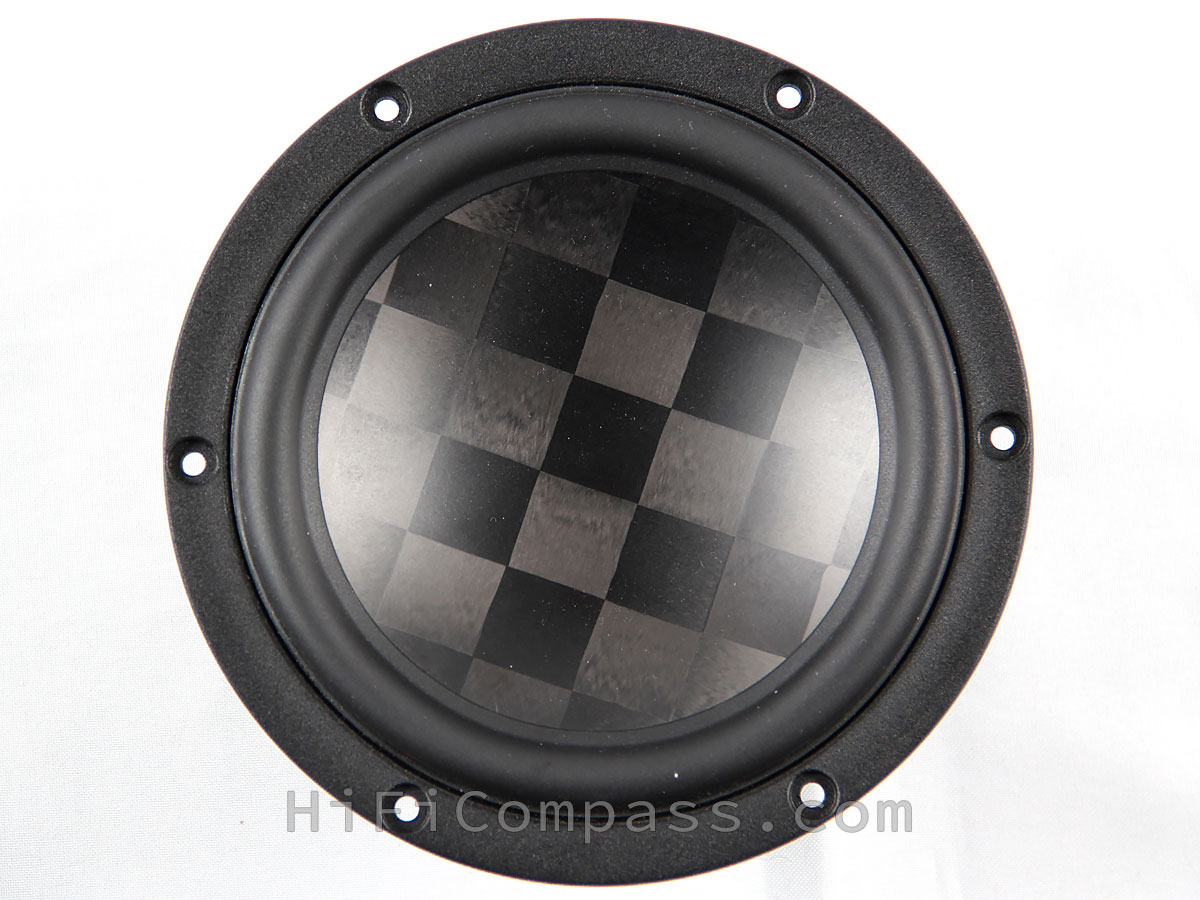 |
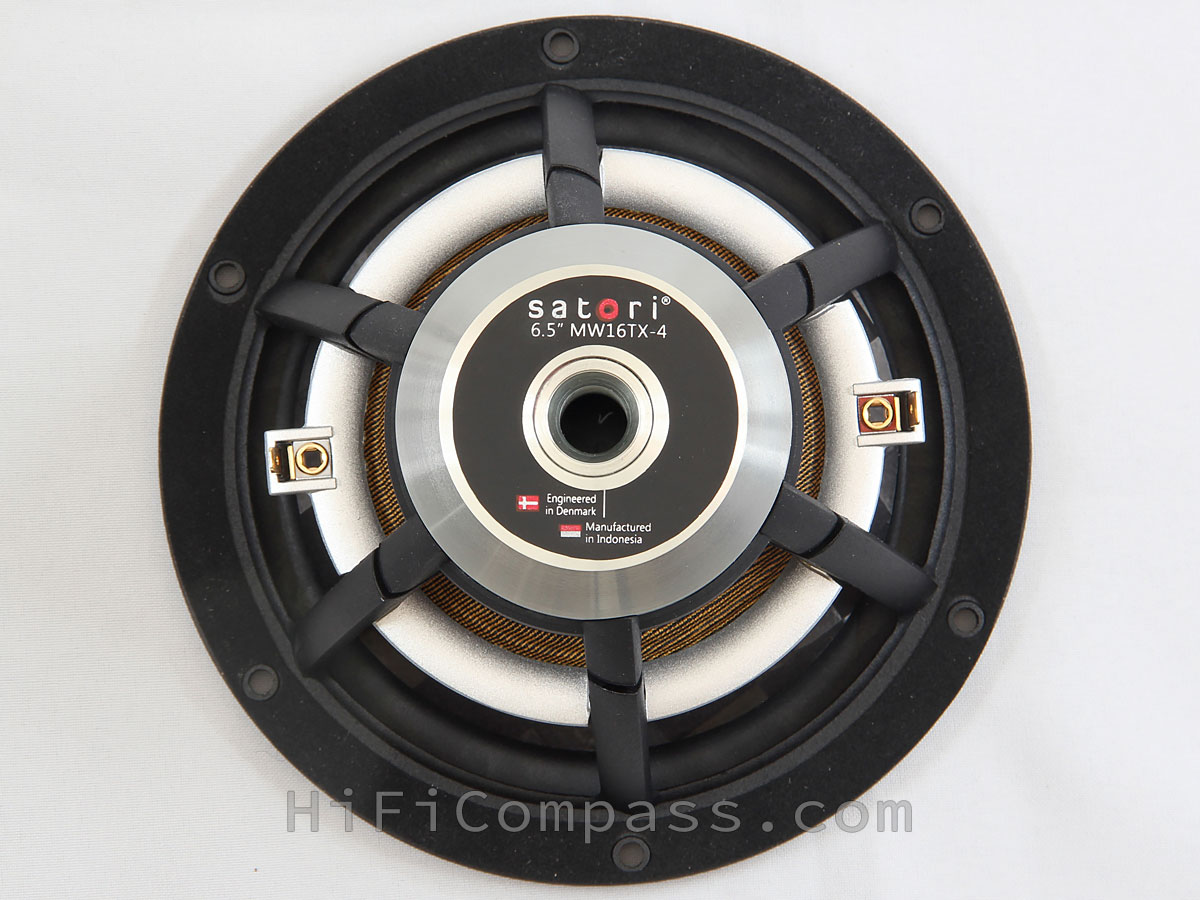 |
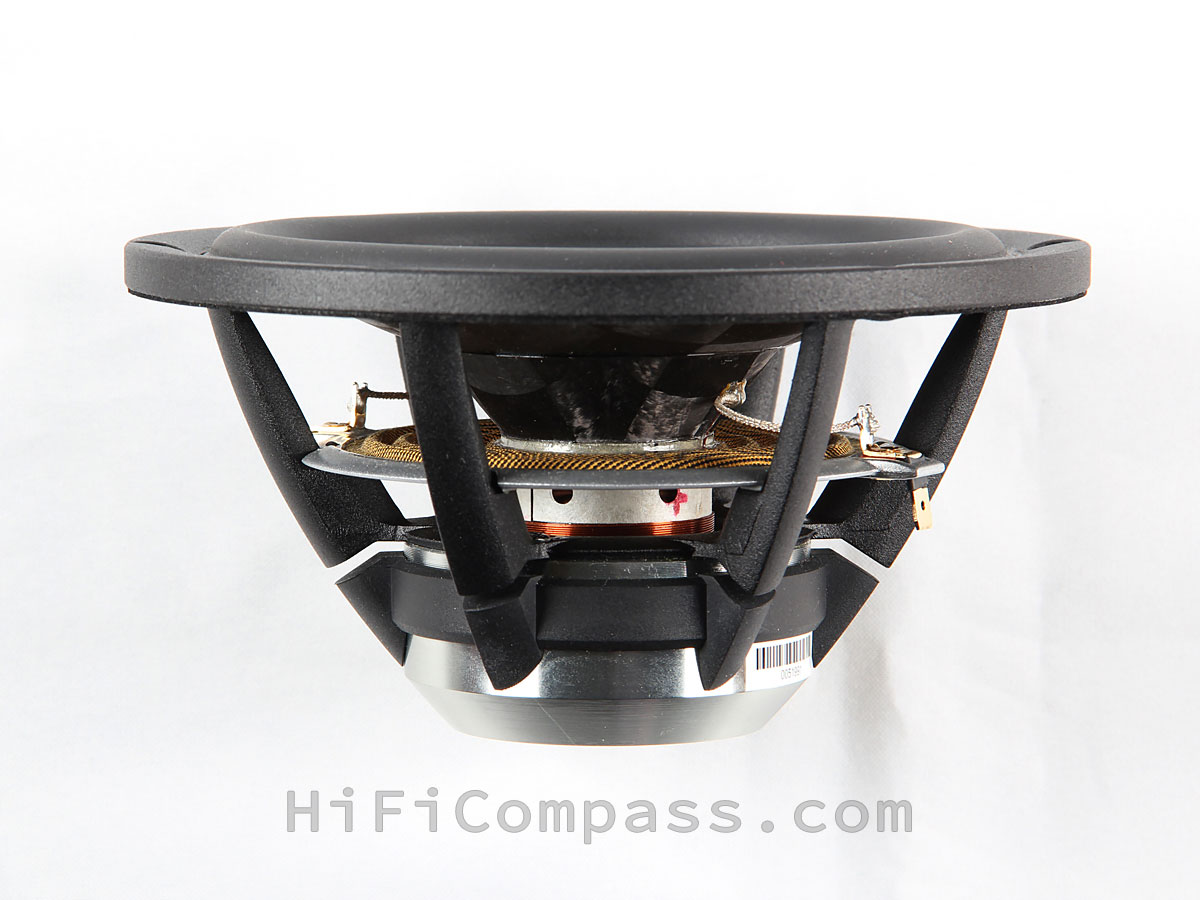 |
The MW16TX-4 comes in a sturdy glossy corrugated cardboard packaging. Inside the box the speaker "sits" in the hole of the U-shaped cardboard frame and is pressed from the front side with a double cardboard spacer. Everything is simple and reliable. The packaging is good, but additional measures to prevent the speaker from scrolling around its axis would not hurt.
The midwoofer is built on the same chassis as the previous model with a paper membrane Satori MW16P-4, and differs only in the membrane and surround.
The production quality is exemplary, there is nothing to complain about. Perfectly fitted parts, complete absence of any cosmetic defects, no burrs, distortions, chips and traces of glue. The label is perfectly aligned.
The acoustically very transparent basket is made of aluminum alloy and coated with black micro-textured powder coating. The flange thickness is 7.5 mm, the spokes are very strong. They did not spared much on material. The baskets of some speakers, when tapped on them with a finger, ring like a tuning fork. One of the most demonstrative examples of this is the Accuton S280-6-282. The MW16TX-4 is not familiar with such problem. The magnetic system is equipped with a rubber ring with shaped elements that visually continue the spokes of the basket. It has no serious functionality, but it nicely complements the design of the basket. A foam gasket is glued to the back of the flange.
All the motor parts are made not by simple casting or stamping, but by precise machining, as evidenced by the traces of the cutter on their outer surfaces. This is one of the conditions for narrowing manufacturing tolerances and improving the consistancy of parameters, as well as an attribute of the highest class speakers. Inside the pole piece there is a vent ending in a 45 degree bevel at both ends. The ring neodymium magnet is not visible as it is covered with the decorative rubber ring.
The surround is made of low loss NBR rubber with a classic half-roll profile. In shape and appearance (due to its micro-roughness) it is more similar to the surrounds of 6" midwoofers of the SB Acoustics SB17xxx35 line compared to the smooth rubber surround of its "paper" sibling Satori MW16P-4.
The four wave spider is made of modern BIMAX material.
The voice coil former has six vent holes through which the copper sleeve on the pole piece is visible.
The flexible silver lead wires are quite stiff and attached to the voice coil former symmetrically at 180 degrees. This contributes to better balancing of the moving system.
The gold-plated terminals are pressed into the aluminum holder and sit very firmly in it. Thanks to the large amount of free space around them, connecting to them is very convenient and simple.
The TeXtreme membrane is about 0.2 mm thick and consists of two layers rotated 45 degrees relative to each other. Unlike classic carbon membranes, it is perfectly smooth with a pleasant matte silky sheen and, thanks to the microfiber structure, shimmers very beautifully at different angles of incidence of light. The sound response of the membrane when tapped or stroked with a finger is very similar to the response of a ping-pong ball, there is no better association.
An unusual element is visible between the voice coil former and the membrane - a cone adapter made of TeXtreme. It serves to transfer and distribute force from the voice coil to the membrane in the most optimal point to reduce the excitation of parasitic vibrations of the membrane.
Ulrik Schmidt: It refers to a piece of felt that sits between the pole core and the copper sleeve. The pole piece is under-cut. Without the felt, there would be an air cavity/space between the two parts and some vibration of the long copper sleeve. The solution was to support the copper sleeve in its entire length below the tip of the pole piece with a piece of felt that would be slightly compressed when mounting the copper sleeve. It relates of all the Satori MW13/MR13, MW16/MR16, MW19 speakers.
Visual inspection revealed excellent modern construction, beautiful design and excellent workmanship.
Impedance frequency response
The first two plots show the impedance frequency responses for one sample of the MW16TX-4 before and after broken-in. The broken-in was carried out for 60 minutes with a sinusoidal voltage of 30 Hz at the level corresponding to the membrane excursion of 8 mm. As you can see, the shape of the curves has changed only in the region of the resonant frequency due to its decrease from 35 Hz to 31.6 Hz. The effect is mainly related to softening the spider. This was also accompanied by a slight decrease in the total Q factor from 0.38 to 0.335.
The second two plots show at different scales the impedance responses of the two MW16TX-4 samples before broken-in. In general, they are very close, but differ slightly in resonant frequency, Qts factor and voice coil DC resistance (about 0.14 Ohm). If the difference was only due to the variation in the suspension compliance, then the sample with the lower Fs would have a lower Qts, which is not actually observed.
The T/S parameters after the broken-in Fs = 31.63 Hz and Qts = 0.335 differ slightly from the declared Fs = 29 Hz and Qts = 0.27. The discrepancy is not critical for the resonant frequency, which will most likely reach 29 Hz with further broken-in. But the quality factor will not be able to drop to 0.27 and will settles somewhere at 0.3.
Thanks to the good motor with a solid copper sleeve on the pole piece, the impedance curve shows very low inductance and small rise with frequency. The response is very smooth, with a slight sign of the main membrane resonance at 5 kHz. As you can see, there are no obvious symptoms of a typical "surround/cone edge" resonance. Only a very large scale allows you to see the small irregularities at 500, 1200 and 3000 Hz.
The impedance response tells us about the well balanced low loss moving system (high mechanical quality factor Qm = 5.2) and the excellent motor.
On-axis frequency response
The measured sensitivity in the range from 150 Hz to 3 kHz averaged 90 - 92 dB. The frequency response has a flat character with no tilt and extends up to 12-13 kHz. In the region of 0.9-1 kHz the response does a step transition from 90 to 92 dB. The overall unevenness does not exceed 3 dB in the range 150 Hz - 4 kHz. In the whole range there is only one distinct 8 dB peak at 5.2 kHz, which is due to the main cone resonance. Otherwise, everything is just fine. In the 0.8-2 kHz region, which is very often problematic in terms of a "surround/cone edge" resonance, the response is smooth.
The frequency response does not imply any difficulties when designing a loudspeaker crossover. Thanks to its flat and very extended range going well beyond 2.5 kHz, it provides designers with great flexibility in the choice of crossover frequency and filter slope. It is even possible to obtain first acoustic order filtering. It's great!
The responses of the two samples are almost identical to each other in shape, but differ in level from 0.2 to 0.4 dB in the range up to 2.5 kHz. For non-matched at a factory midwoofers this is a very good result.
The measured frequency response corresponds fairly well with the datasheet.
Off-axis frequency responses (at 315 mm)
Above are the plots of the regular and normalized off-axis frequency responses. For the normalized plot the axial frequency response is taken as the reference and the off-axis ones reflect only the difference with it.
With the off-axis deviation the small hump at 3 kHz begins to appear, which is almost invisible on the axial frequency response.
The 30-degree frequency response from the datasheet agrees well with the measured one. But the 60-degree response is more like as if it was measured at 40-degree.
Harmonic distortion (at 315 mm)
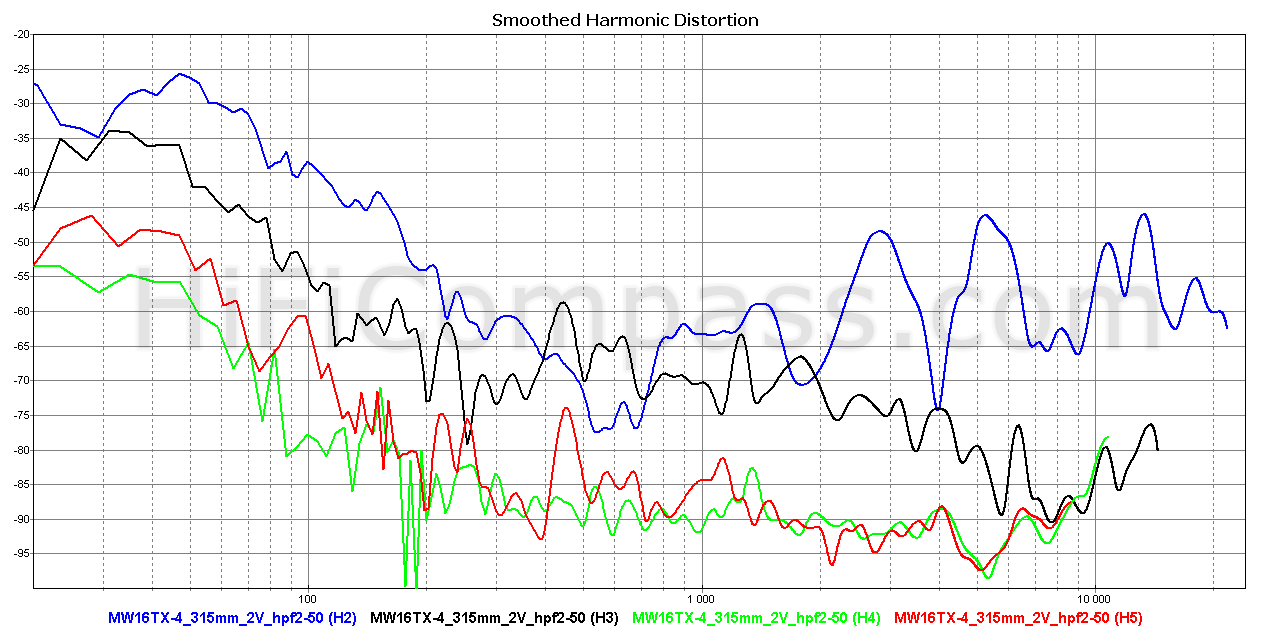 |
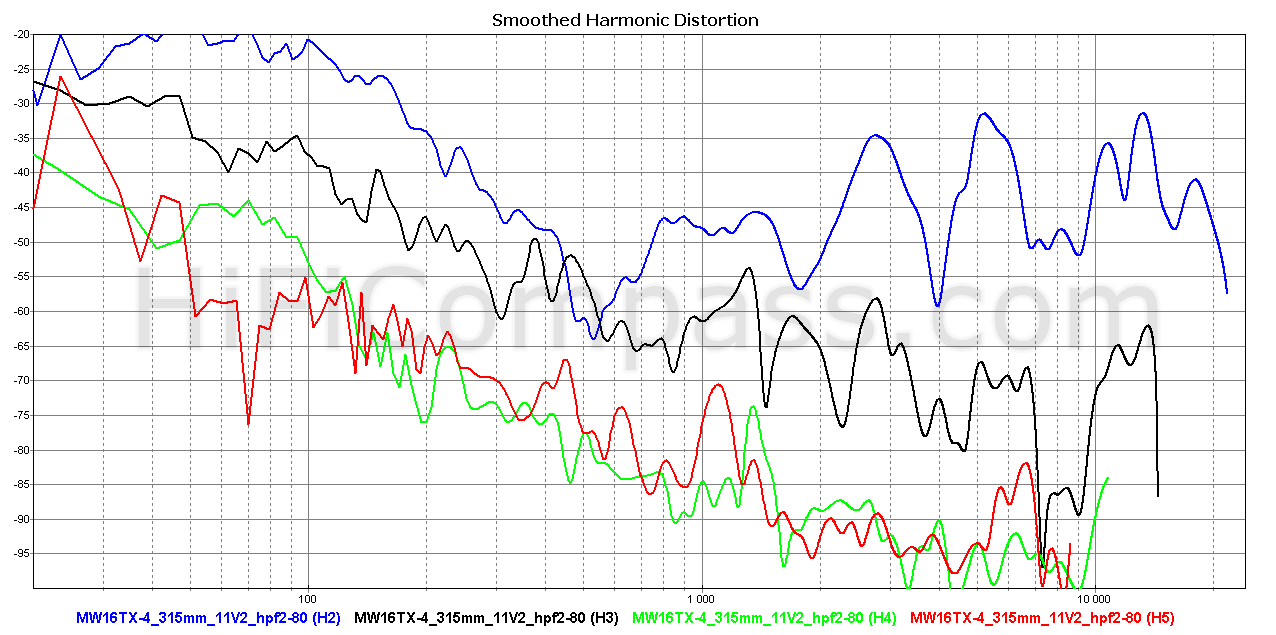 |
Above are the harmonic distortions plots for the 2nd - 5th harmonics at average sound pressure levels of 87 and 102 dB (at voltages of 2 and 11.2 Volts respectively). To limit the speaker overload in terms of thermal power and membrane displacement when measuring harmonic distortion, a second-order Butterworth type high-pass filter with a cutoff frequency of 50 Hz was used. On these graphs we analyze the frequency range only from 200 Hz and above.
The second harmonic dominates the entire frequency range and at all sound pressure levels. The third harmonic goes several dB lower, and the fourth and fifth even lower with a large margin. The harmonic distortion pattern is stable at both frequency and SPL. There are no sudden abrupt jumps in distortion over the entire range due to the membrane break-up, especially at high SPL. With an increase in the input voltage, starting from 500 Hz and below, harmonics of all orders begin to grow monotonically.
At a frequency of 2.8 kHz only a burst of the 2nd harmonic is observed. Is it the trace of the up-shifted and well masked resonance of the edge of cone? The frequency range higher than 4 kHz is out of interest.
I would rate the harmonic distortion above 200 Hz as "very low", one of the lowest I have ever seen in 6" midwoofers. Excellent!
Harmonic distortion (at 20 mm)
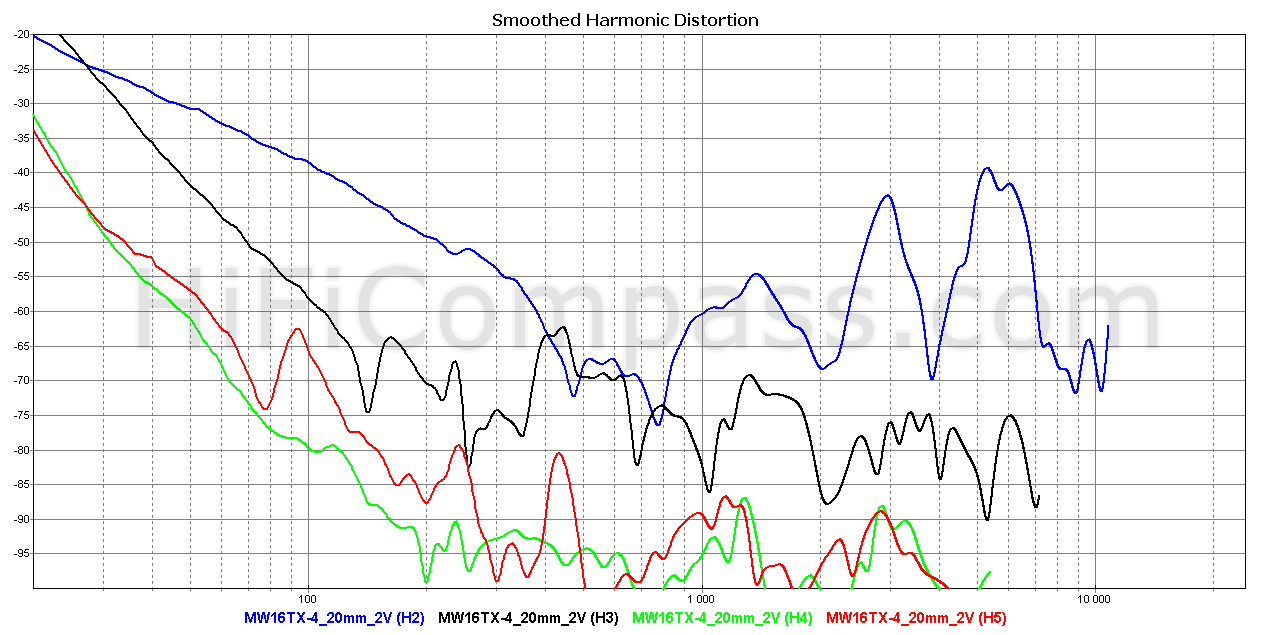 |
 |
This measurement method provides the more accurate estimate of the harmonic distortion below 200 Hz compared to the measurements at 315mm.
Again, the 2nd harmonic is dominant over the entire frequency and input voltage range. The behavior and hierarchy of all harmonic components below 200 Hz corresponds to their behavior above 200 Hz. With decreasing frequency all harmonics increase monotonically.
Due to the increased level of the 2nd harmonic the total harmonic distortion below 100 Hz is higher than that of most midwoofers of this size and class. At least, the 6" SB Acoustics midwoofers (you can check here - SB17MFC35-4, SB17CRC35-4, SB17NBAC35-8) perform better in this range.
Voice coil current harmonic distortion
 |
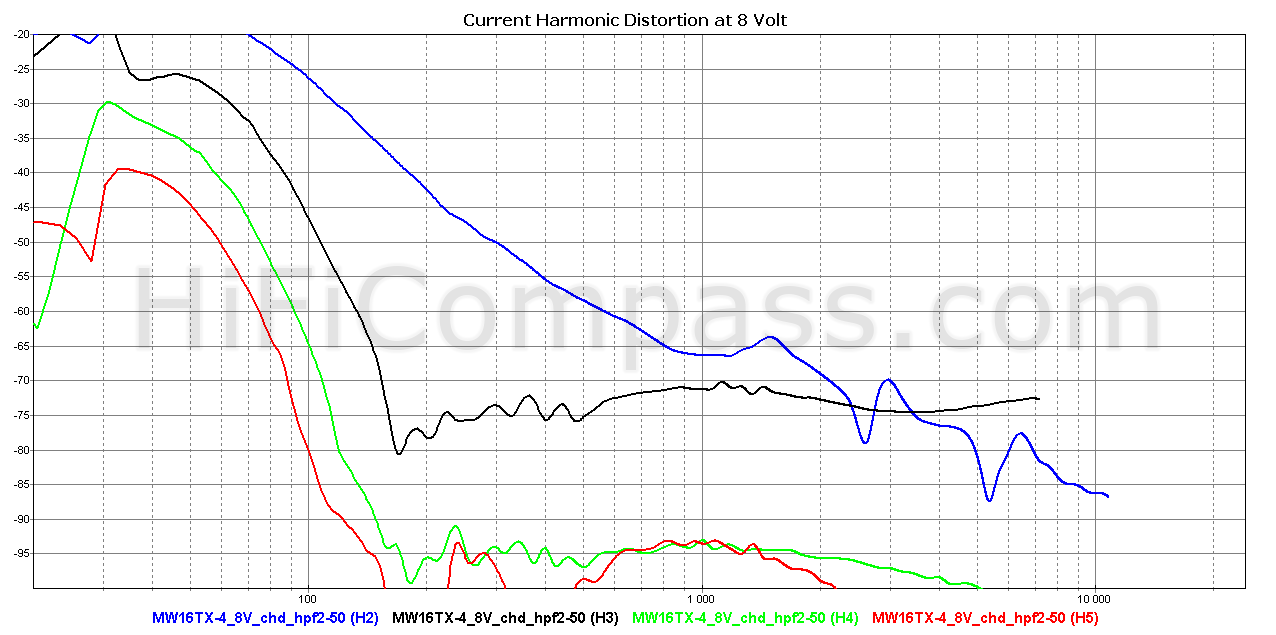 |
This type of measurement, despite its simplicity, is an excellent tool for assessing the linearity of a speaker motor. The above plots show the frequency dependences of the 2nd, 3rd, 4th and 5th harmonics of the voice coil current at 2 and 8 Volt. To limit the speaker overload in terms of the membrane displacement when measuring harmonic distortion, a second-order Butterworth type high-pass filter with a cutoff frequency of 50 Hz was used.
Voice coil current nonlinearity is the direct nonlinearity of the mechanical force driving the speaker cone, since this force is related to the current by a simple relationship F=B*L*I, where B is the magnetic field strength, L is the length of the voice coil wire inside the magnetic gap and I is the current. So, in principle, it is practically impossible to obtain sound pressure distortion lower than current distortion in the frequency range where the contribution of the motional nonlinearity becomes insignificant.
We don't even need to talk about the fourth and fifth harmonics above 100 Hz. The second harmonic of the current also linearly depends on the voltage level, as well as the second harmonic of the sound pressure. The third harmonic above 150 Hz is almost independent of the input voltage. Below 150 Hz, due to an increase in the membrane displacement amplitude, a sharp increase in harmonics of all orders begins.
Intermodulation distortion
The intermodulation distortion measurement is one of way of analyzing device non-linearity. It is not an alternative, but an additional method and allows you to identify the spectral components of the inharmonious structure, which are much more harmful for high-quality sound reproduction and to which our hearing is more sensitive.
- test frequencies
- 2nd order harmonic distortion components for the test frequencies (2nd HD)
- 3rd order harmonic distortion components for the test frequencies (3rd HD)
- 2nd order intermodulation distortion amplitude (IMA2)
- 3rd order intermodulation distortion amplitude (IMA3)
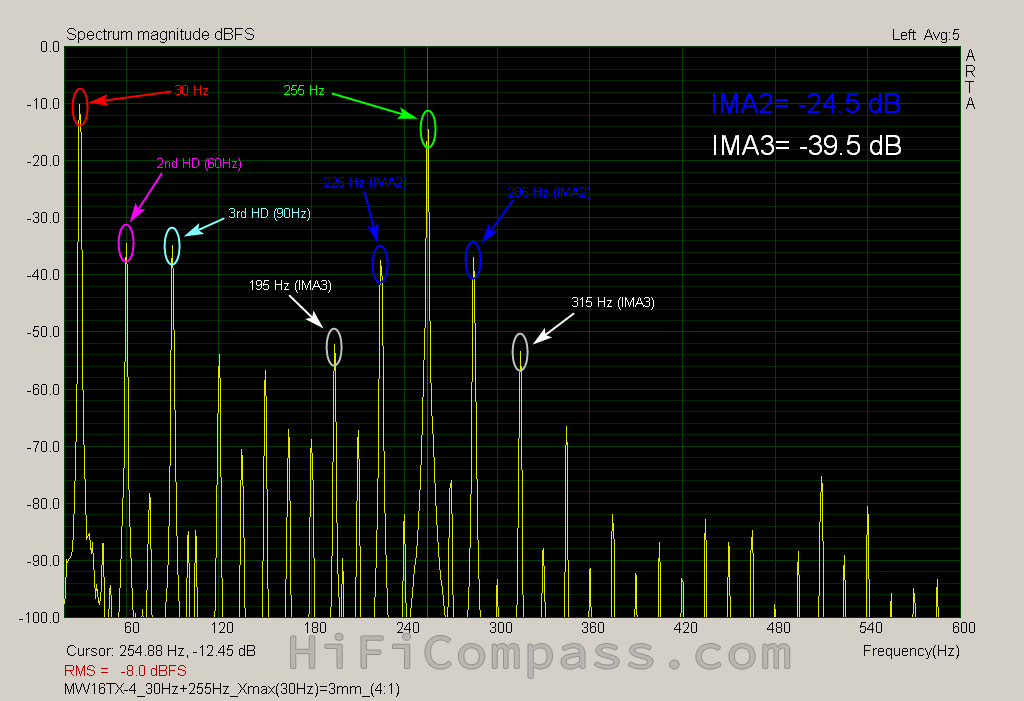 |
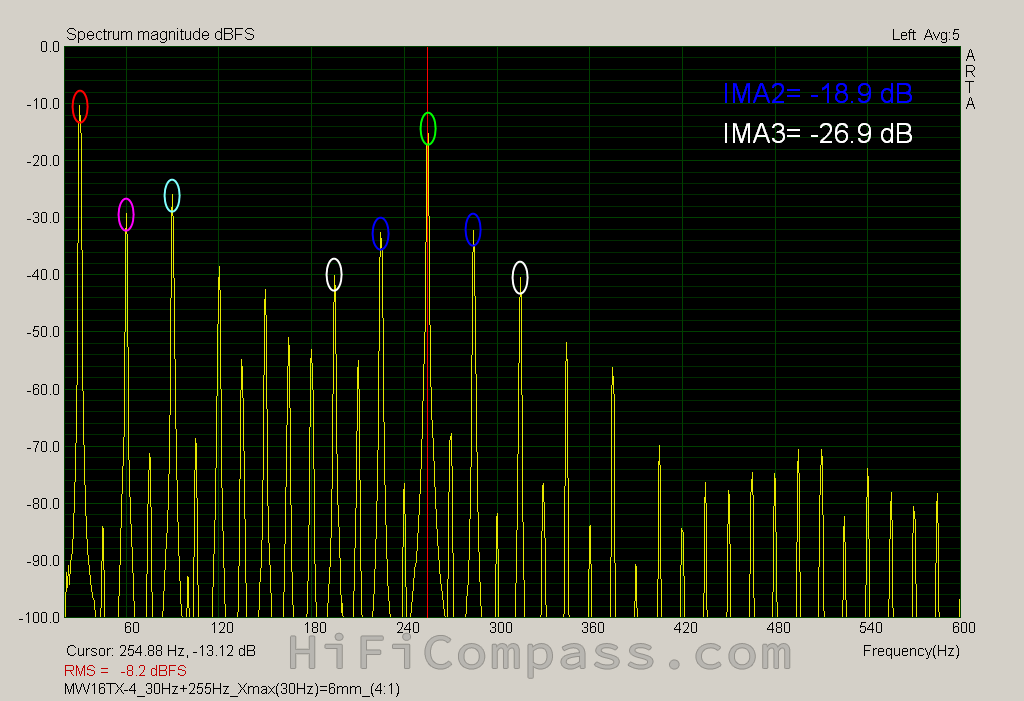 |
As you can see, just a couple of frequencies at the speaker terminals give rise to a whole forest of parasitic components at its output. The second order intermodulation components are -24.5 dB and -18.9 dB for the cone excursion of 3 mm and 6 mm respectively. If IMA2 = -24.5 dB is a fairly moderate value, then -18.9 dB is already poor. These results were obtained when the cone excursion was within its Xlinear max limits (+/- 6.5 mm accordingly to the datasheet).
I would rate the intermodulation distortion as "higher than average".
Step response
The transient response exhibits excellent slew rate and smooth decay. The oscillatory process is observed only within 1 ms of the initial part of the decay. It is caused by the membrane resonance at 5.2 kHz.
Waterfall
The waterfall shows the same effects as a step response, in addition exposing hidden resonances that are difficult to see in other types of measurements.
At 5.2 kHz we observe a ridge from the main resonance of the membrane, which completely disappears in just 2.7 ms. Otherwise, everything is fine, the moving system calms down very quickly. Everything is perfect in the 800 Hz - 2 kHz region.
Listening impressions. Satori MW16TX versus Satori MW16P
As such a reference point I decided to use the sound of the Satori MW16P-4 midwoofer. This pressed paper cone midwoofer with reinforcing papyrus fibers has been the flagship of Sinar Baja Electric for nearly 10 years. During this time it managed to conquer thousands of audiophile hearts, including mine. In fact, since the MW16P hit the market, I consider it to be one of the best 6" midwoofers available no matter the price. I think many are familiar with its sound, so it will be easier for them to understand me.
At first, let's make an objective comparison of the speakers according to their main characteristics. Both speakers are identical except for the moving systems. There is no point in comparing below 200 Hz, everything is almost the same there, and so are the T/S parameters. Therefore, we look only above 200 Hz.
 |
 |
So, the frequency response of the MW16TX is better everywhere except the peak at 5.2 kHz, which is clearly outside the potential operating frequency range of the midwoofer (up to 2-2.5 kHz) and will not create any problems, except for additional filtering. In the critical region of 0.8-2 kHz the MW16TX is better than the MW16P.
The MW16TX does much better with the 2nd harmonic distortion up to 1.4 kHz. There is approximate parity for the 3rd and 5th harmonics. By the 4th one the MW16P is slightly behind due to a wide burst in the 900 - 1400 Hz region.
From an objective technical point of view the MW16TX is one step higher than the MW16P.
I decided to make the subjective comparison "by ear" in the most realistic and identical conditions, namely, to compare midwoofers, that is built into real loudspeakers. To do this, I replaced the MW16P-4 with the MW16TX-4 in one of my two-way loudspeaker based on the Satori MW16P-4/Satori TW29R and adjusted its crossover to achieve the same frequency responses of both midwoofers. The MW16TX low pass filter had been corrected in the range of 1-3 kHz and the 5.2 kHz resonance notch had been added. I listened to them one by one, switching the speakers on the fly using the A/B relay. The comparison lasted unhurriedly over several days in order to exclude the influence of a possible "wow-effect" and using a wide variety of musical material.
The influence of the 5.2 kHz notch for the MW16TX-4 was tested too. In the end, I compared only the midwoofers, with low pass filters, but without the tweeters.
The overall presentation and sound character of both speakers are similar, family traits and continuity can be clearly traced. You won't confuse it with the sound of ScanSpeak, SEAS, Purifi, Accuton or others.
The first and foremost difference between the midwoofers is the MW16TX transparency, clarity, purity. It's clearly above and that's it, with no discussion and in any configurations. It feels as if you slightly wiped your glasses or removed the curtain, removed the veil or focused the binoculars - choose the comparison that works best for you.
Secondly, the MW16TX sounds smoother and more balanced in timbre.
Third, at increased volume the MW16TX never lost control, the sound retained its light and transparent character, while the MW16P began to exhibit its "paper shouting" and loss of intelligibility in the upper middle. This was perfectly heard on complex symphonic music during string passages or when wind instruments came into play, as well as on choral singing and female vocals.
Fourth, the MW16TX treats the attack of percussion and stringed plucked instruments much better, sharper, more accented and outlined.
Compared with the MW16P the sound of the MW16TX often seemed closer to a listener, i.e. localized closer to the front panel than in the middle of the loudspeaker cabinet.
"How to use" recomendations
The MW16TX-4 is an universal soldier. It can can be used as a midwoofer in 2- and 2.5-way loudspeakers, as well as a midrange in 3-way loudspeakers up to 3 kHz. Maybe, someone would like to try it as a fullrange with a supertweeter? Moreover, it seems to me that its flawless behavior in the 200 Hz - 3 kHz range saves the manufacturer from the need to release a special TeXtreme midrange, as was the case with the paper MW16P and MR16P.
The range below 100 Hz is not the MW16TX-4's strongest point in terms of distortion. My experience with the MW16P confirms that in a bass-reflex design it can easily reach a lower cutoff frequency of F3 = 38-40 Hz, while providing acceptable bass quality as for a 6" midwoofer. The MW16TX-4 can't boast of super reslolution in the middle and upper bass, but here it will fully reward you with a warm, rich and mellow timbre.
What is the price and where to purchase it?
The MW16TX-4 are already on the market. The retail price is €216-260 per piece excluding VAT. It can be purchased in the following online stores:
- https://solen.ca/products/speakers/home-speakers/woofers/sb-acoustics-sa...
- https://www.madisoundspeakerstore.com/approx-6-7-woofers-satori/satori-6...
- https://www.audiohobby.eu/ru/sb-acoustics-woofers/15123-sb-acoustics-sat...
- https://audio-hi.fi/ru/sb_acoustics_mw16tx-4_2971-p-5076.html
- https://www.soundimports.eu/en/sb-acoustics-satori-mw16tx-4.html
Summary
The MW16TX-4 is a worthy addition to the Satori line. It has surpassed its paper predecessor in terms of frequency response evenness, nonlinear distortion and sound resolution. I see no flaws in it, except for the mediocre second order harmonic distortion and intermodulation distortion below 200 Hz. The very extended frequency response gives loudspeaker designer a lot of flexibility, allowing almost any filtering order (slope) to be used. A more rigid TeXtreme membrane has added transparency and detail to the sound, but did it very delicately, without introducing into the sound of coldness, emptiness, ringing and sterility, as is often the case with metal or ceramic materials. An excellent debut for the TPCD membrane.
This is possible due to the fact that the datasheet was given for a prototype, and the tests were carried out already on the production model.
Based on the measurements and listening results, I consider the MW16TX-4 one of the best available 6" midwoofers today regardless of price.
Summarizing the above, I can highlight the following:
- sensitivity above average - from 90 to 92 dB/2.83 V*1 m
- very extended and even frequency response
- very low harmonic distortion above 200 Hz
- higher than average 2nd order harmonic distortion below 250 Hz
- higher than average intermodulation distortion at low frequencies
- can be used up to 3 kHz
- slight deviation the measured Qts from the datasheet
- 60-degrees off-axis frequency respons from the datasheet doesn't match to the measured one
- acceptable consistency of parameters and characteristics
- excellent production quality
You can get more information about the measurement results here
Yevgeniy Kozhushko/21.01.2021
CONTACTS
- Ukraine
- (+380) 95 904 7827
- hificompass@gmail.com
LAST NEWS
-
27 Mar 2025
-
04 Mar 2025
-
25 Feb 2025
-
10 Feb 2025
